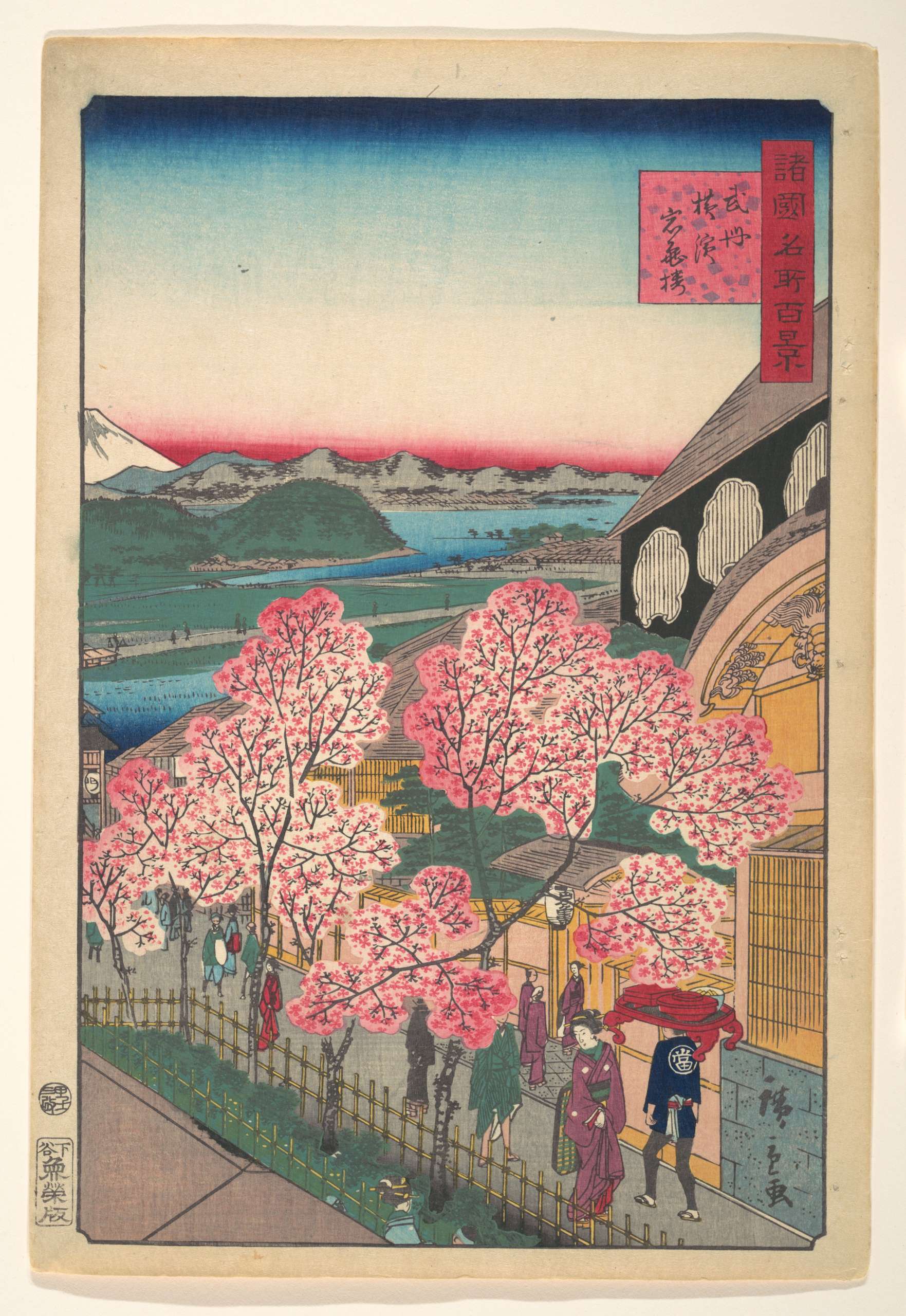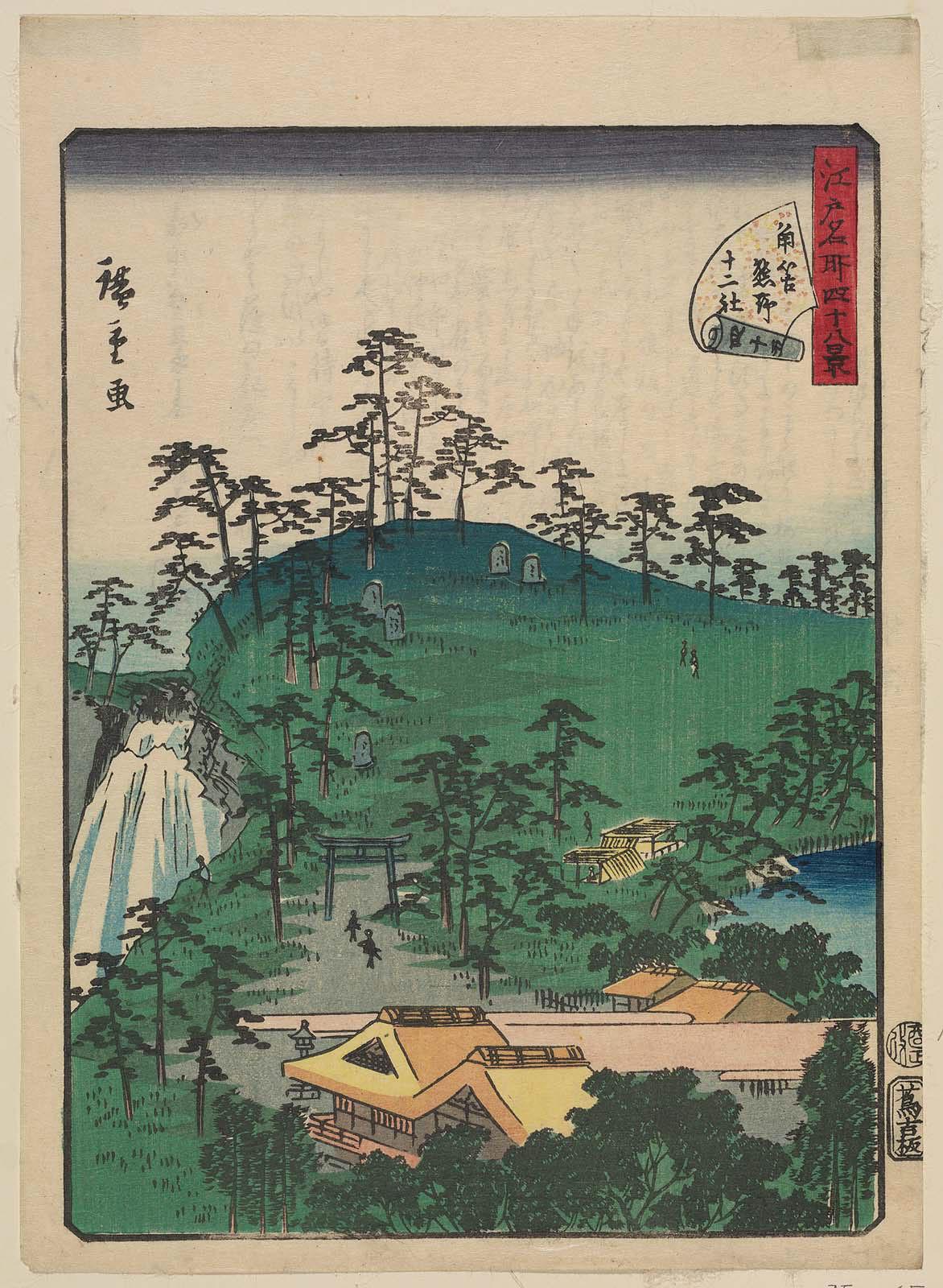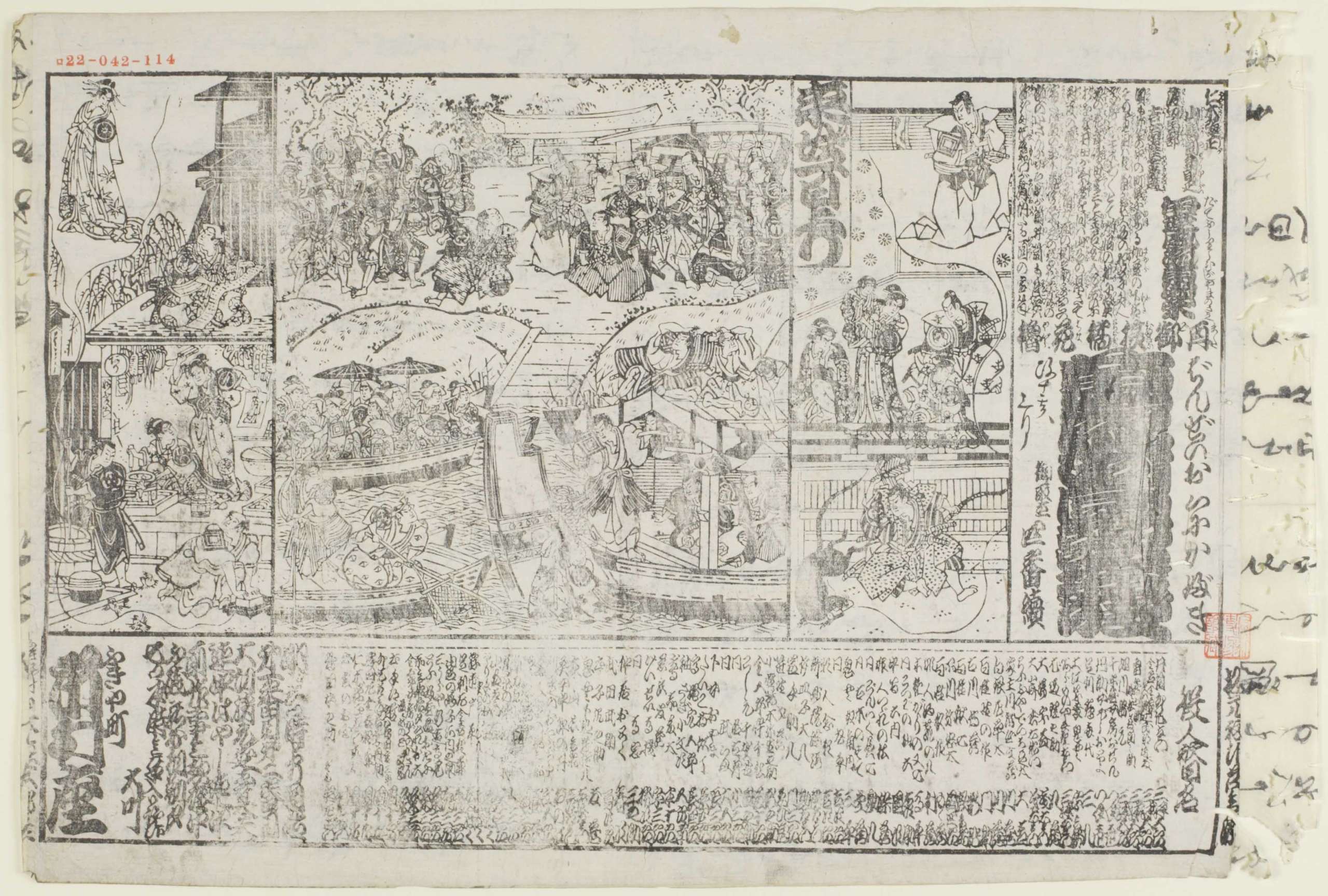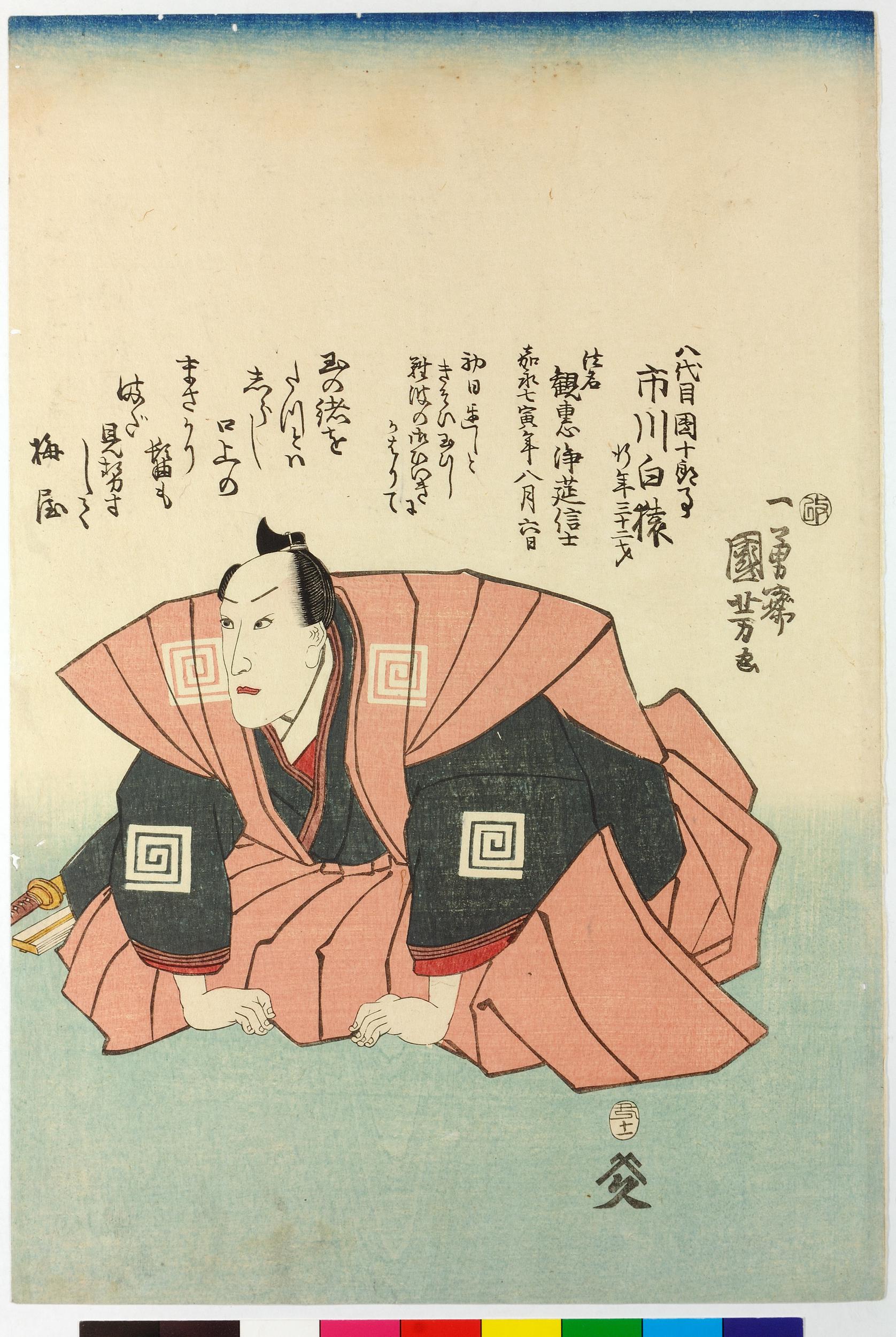-
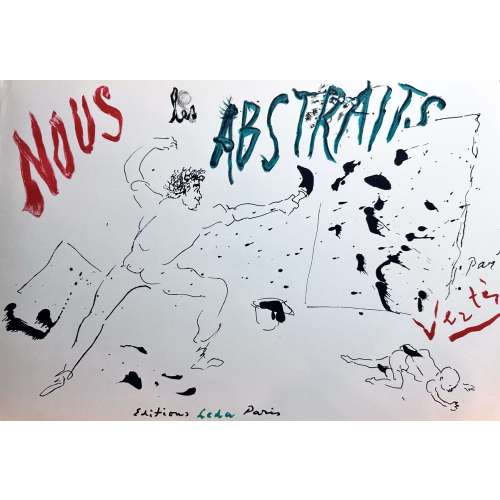 NEWHalf-bound green over grey cloth flapped folder 530 x 370 mm with laces, 3 in-folio folded leaves with text (6 pages) and drawn title-page plus 30 colour offset lithographs 510 x 350 mm after Marcel Vertès. Print run limited to 331 copies with 278 on Sirène, of which this is copy № 51. Title-page: VERTÈS | Nous les Abstraits | Préface de | Roger Peyrefitte || Imprint: © 1960 BY ÉDITIONS LÉDA, 36, RUE ÉTIENNE-MARCEL, PARIS 2° || Colophon: ACHEVÉ D'IMPRIMER | LE 18 AVRIL 1960 |PAR | JACQUES LONDON, IMPRIMEUR | POUR LA PRÉFACE | ET | RENÉ GUILLARD | POUR LES LITHOGRAPHIES || Limitation: CET OUVRAGE A ÉTÉ TIRÉ A 331 EXEMPLAIRES | DONT : UN EXEMPLAIRE UNIQUE COMPORTANT TROIS DESSINS | ORIGINAUX ET DEUX DESSINS ORIGINAUX REFUSÉS, LA | SUITE COMPLÈTE DES PLANCHES AQUARELLÉES A LA | MAIN PAR L'ARTISTE ET QUINZE CROQUIS ORIGINAUX | DE PRÉPARATION. (EXEMPLAIRE NUMÉROTÉ UN.) | 5 EXEMPLAIRES SUR VÉLIN D'ARCHES COMPORTANT | DEUX DESSINS ORIGINAUX ET UN DESSIN ORIGINAL | REFUSÉ, TROIS PLANCHES AQUARELLÉES A LA MAIN, DEUX | PLANCHES REFUSÉES ET CINQ CROQUIS ORIGINAUX, | NUMÉROTÉS DE 2 A 6. | 17 EXEMPLAIRES SUR VÉLIN D'ARCHES COMPORTANT UN | DESSIN ORIGINAL, UNE PLANCHE REFUSÉE ET UN CROQUIS | ORIGINAL, NUMÉROTÉS DE 7 A 23. | 278 EXEMPLAIRES SUR OFFSET SIRÈNE, NUMÉROTÉS DE 24 A 301 | 30 | EXEMPLAIRES HORS COMMERCE NUMÉROTÉS H.C. I | A H.C. XXX. 51 || Marcel Vertès [Marcell Vértes] (Jewish-Hungarian-French, 1895 – 1961) – artist/author Pierre Roger Peyrefitte (French, 1907 – 2000) – author/preface. Imprimerie London (Paris); Jacques [Jankiel] London (Jewish-Ukrainian-French, 1910 – 2011) – printer/text. René Guillard (French, 1889 – after 1961) – printer/lithographs.
NEWHalf-bound green over grey cloth flapped folder 530 x 370 mm with laces, 3 in-folio folded leaves with text (6 pages) and drawn title-page plus 30 colour offset lithographs 510 x 350 mm after Marcel Vertès. Print run limited to 331 copies with 278 on Sirène, of which this is copy № 51. Title-page: VERTÈS | Nous les Abstraits | Préface de | Roger Peyrefitte || Imprint: © 1960 BY ÉDITIONS LÉDA, 36, RUE ÉTIENNE-MARCEL, PARIS 2° || Colophon: ACHEVÉ D'IMPRIMER | LE 18 AVRIL 1960 |PAR | JACQUES LONDON, IMPRIMEUR | POUR LA PRÉFACE | ET | RENÉ GUILLARD | POUR LES LITHOGRAPHIES || Limitation: CET OUVRAGE A ÉTÉ TIRÉ A 331 EXEMPLAIRES | DONT : UN EXEMPLAIRE UNIQUE COMPORTANT TROIS DESSINS | ORIGINAUX ET DEUX DESSINS ORIGINAUX REFUSÉS, LA | SUITE COMPLÈTE DES PLANCHES AQUARELLÉES A LA | MAIN PAR L'ARTISTE ET QUINZE CROQUIS ORIGINAUX | DE PRÉPARATION. (EXEMPLAIRE NUMÉROTÉ UN.) | 5 EXEMPLAIRES SUR VÉLIN D'ARCHES COMPORTANT | DEUX DESSINS ORIGINAUX ET UN DESSIN ORIGINAL | REFUSÉ, TROIS PLANCHES AQUARELLÉES A LA MAIN, DEUX | PLANCHES REFUSÉES ET CINQ CROQUIS ORIGINAUX, | NUMÉROTÉS DE 2 A 6. | 17 EXEMPLAIRES SUR VÉLIN D'ARCHES COMPORTANT UN | DESSIN ORIGINAL, UNE PLANCHE REFUSÉE ET UN CROQUIS | ORIGINAL, NUMÉROTÉS DE 7 A 23. | 278 EXEMPLAIRES SUR OFFSET SIRÈNE, NUMÉROTÉS DE 24 A 301 | 30 | EXEMPLAIRES HORS COMMERCE NUMÉROTÉS H.C. I | A H.C. XXX. 51 || Marcel Vertès [Marcell Vértes] (Jewish-Hungarian-French, 1895 – 1961) – artist/author Pierre Roger Peyrefitte (French, 1907 – 2000) – author/preface. Imprimerie London (Paris); Jacques [Jankiel] London (Jewish-Ukrainian-French, 1910 – 2011) – printer/text. René Guillard (French, 1889 – after 1961) – printer/lithographs. -
 NEWSoftcover volume 245 x 195 mm in cream French flapped wrapper with blue lettering to front, printed on wove paper with Arches watermarkes, header and footer framed in blue arabesque; pp.: ffl [1-4] 5-124 [125] [3] ffl, i.e. 64 leaves plus 12 colour lithographs by Schem (Raoul Serres), incl. frontispiece. A print run of 325 copies, of which this is copy № 69 on Arches vellum. Title-page (blue and black): MARQUIS DE SADE | HISTOIRE | DE JÉRÔME | ILLUSTRÉE D'EAUX-FORTES ORIGINALES | REHAUSSÉES DE COULEURS | PAR UN | ARTISTE INCONNU | PARIS | CHEZ TOUS LES LIBRAIRES | MCMXXXVI || Colophon: JUSTIFICATION DU TIRAGE. Cette édition du Marquis de Sade, illustrée de 12 eaux-fortes originales d'un artiste célèbre, a été strictement limitée à 325 exemplaires sur grand vélin d'Arches à la forme. N° 1. Exemplaire unique sur Japon impérial, comprenant l'état définitif en couleurs des I2 eaux-fortes, une suite en noir avec remarques un cuivre et les 12 dessins originaux. Nos 2 et 3 sur Japon impérial, comprenant l'état définitif en couleurs des 12 eaux-fortes, une suite en noir avec remarques et un dessin de l'artiste. Nos 4 à 12 sur grand vélin d'Arches à la forme, comprenant l'état définitif en couleurs des I2 eaux-fortes, une suite en noir avec remarques un cuivre et un dessin de l'artiste. Nos 13 à 50 sur grand vélin d'Arches à la forme comprenant l'état définitif en couleurs des 12 eaux-fortes et suite en noir avec remarques. Nos 51 à 325 sur grand vélin d'Arches à la forme avec l'état définitif en couleurs des 12 eaux-fortes. Catalogue raisonné: Dutel III № 1697, p. 199. Contributors: Donatien Alphonse François, Marquis de Sade (French, 1740 – 1814) – author. Schem [real name Raoul Serres] (French, 1881– 1971) – artist.
NEWSoftcover volume 245 x 195 mm in cream French flapped wrapper with blue lettering to front, printed on wove paper with Arches watermarkes, header and footer framed in blue arabesque; pp.: ffl [1-4] 5-124 [125] [3] ffl, i.e. 64 leaves plus 12 colour lithographs by Schem (Raoul Serres), incl. frontispiece. A print run of 325 copies, of which this is copy № 69 on Arches vellum. Title-page (blue and black): MARQUIS DE SADE | HISTOIRE | DE JÉRÔME | ILLUSTRÉE D'EAUX-FORTES ORIGINALES | REHAUSSÉES DE COULEURS | PAR UN | ARTISTE INCONNU | PARIS | CHEZ TOUS LES LIBRAIRES | MCMXXXVI || Colophon: JUSTIFICATION DU TIRAGE. Cette édition du Marquis de Sade, illustrée de 12 eaux-fortes originales d'un artiste célèbre, a été strictement limitée à 325 exemplaires sur grand vélin d'Arches à la forme. N° 1. Exemplaire unique sur Japon impérial, comprenant l'état définitif en couleurs des I2 eaux-fortes, une suite en noir avec remarques un cuivre et les 12 dessins originaux. Nos 2 et 3 sur Japon impérial, comprenant l'état définitif en couleurs des 12 eaux-fortes, une suite en noir avec remarques et un dessin de l'artiste. Nos 4 à 12 sur grand vélin d'Arches à la forme, comprenant l'état définitif en couleurs des I2 eaux-fortes, une suite en noir avec remarques un cuivre et un dessin de l'artiste. Nos 13 à 50 sur grand vélin d'Arches à la forme comprenant l'état définitif en couleurs des 12 eaux-fortes et suite en noir avec remarques. Nos 51 à 325 sur grand vélin d'Arches à la forme avec l'état définitif en couleurs des 12 eaux-fortes. Catalogue raisonné: Dutel III № 1697, p. 199. Contributors: Donatien Alphonse François, Marquis de Sade (French, 1740 – 1814) – author. Schem [real name Raoul Serres] (French, 1881– 1971) – artist. -
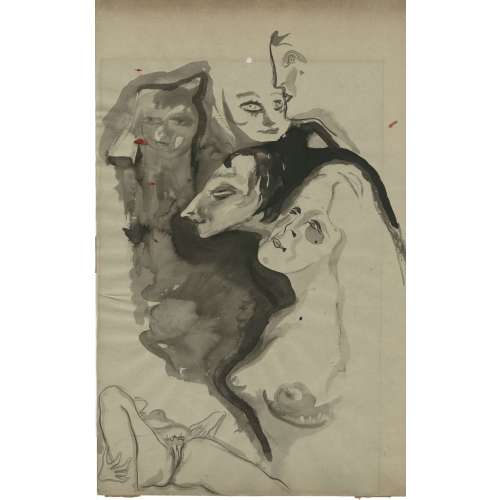 NEW"The Jewish Hungarian artist Nicolas Sternberg moved to Paris in the 1920s, remaining there for the rest of his life, hiding during the German occupation of the city in the 1940s under false identity papers". [MIA: Minneapolis Institute of Art, cited] Jean-Pierre Dutel provides the following information: Nicolas Sternberg was born to Jewish parents on July 9, 1902, in Nagyvárad, in Austro-Hungary. According to the archives of the Préfecture de police in Paris (1930), he was Hungarian. His real name was Miklós Szines-Sternberg. At the time, it was common among painters and sculptors to retain their original German names while adopting Hungarian-German double surnames. From age twelve, he worked as a newspaper illustrator in Budapest before moving to Paris in the early 1920s after studying in Munich. He published regularly in Paris-Soir, one of the most important French daily newspapers between the wars. Despite his talent, only one solo exhibition seems to have been dedicated to him at the Galerie Georges Petit (Georges Petit, 1856–1920) in 1929. Jules Pascin (1885 –1930) exhibited there in 1930 and committed suicide on the opening day. Sternberg is known for his drawings devoted to the circus, madmen, and pornography. He excelled in portraits and self-portraits, particularly fine portraits of his wife Miche and his friend Michel Simon (1895–1975). In 1927, he made drawings for Les Flambeaux de la Noce, a play at the Comédie-Française. He also contributed to the illustration of La Légende des sexes by Edmond Haraucourt (1856 –1941). In 1930, he created illustrations for Les Aventures du Roi Pausole by Pierre Louÿs (1870–1925), published by Simon Kra (1853–1940), and for an edition of the bawdy songs Les Trois Orfèvres à la Saint Éloi, which led to an investigation into its publisher and illustrator. He also produced original watercolours for an edition of Manuel de Civilité by Pierre Louÿs. In 1933, he illustrated Madame de Pompadour by Paul Reboux (1877 –1963). In 1937, Sternberg illustrated Souls and Secrets, a collection of Hasidic stories by József Patai (1882–1953), translated by his son, the anthropologist, ethnologist, and historian Raphael Patai (Budapest, 1910 – Tucson, 1996), who kept some of Sternberg’s works in his home. Portraits of Michel Simon dating from 1932, along with numerous pornographic photographs of Sternberg taken by the actor between 1940 and 1960, demonstrate the longevity of their relationship. In 1940, Sternberg miraculously escaped the Nazi’s aerial bombardment that killed several members of his family. During the Occupation, he lived in hiding with false papers and resumed his career in Paris after the war. Despite visual differences, Jules Pascin and Nicolas Sternberg shared some curious similarities. Their works, though employing different techniques, reflect the same underlying despair. Like Pascin, Sternberg committed suicide.
NEW"The Jewish Hungarian artist Nicolas Sternberg moved to Paris in the 1920s, remaining there for the rest of his life, hiding during the German occupation of the city in the 1940s under false identity papers". [MIA: Minneapolis Institute of Art, cited] Jean-Pierre Dutel provides the following information: Nicolas Sternberg was born to Jewish parents on July 9, 1902, in Nagyvárad, in Austro-Hungary. According to the archives of the Préfecture de police in Paris (1930), he was Hungarian. His real name was Miklós Szines-Sternberg. At the time, it was common among painters and sculptors to retain their original German names while adopting Hungarian-German double surnames. From age twelve, he worked as a newspaper illustrator in Budapest before moving to Paris in the early 1920s after studying in Munich. He published regularly in Paris-Soir, one of the most important French daily newspapers between the wars. Despite his talent, only one solo exhibition seems to have been dedicated to him at the Galerie Georges Petit (Georges Petit, 1856–1920) in 1929. Jules Pascin (1885 –1930) exhibited there in 1930 and committed suicide on the opening day. Sternberg is known for his drawings devoted to the circus, madmen, and pornography. He excelled in portraits and self-portraits, particularly fine portraits of his wife Miche and his friend Michel Simon (1895–1975). In 1927, he made drawings for Les Flambeaux de la Noce, a play at the Comédie-Française. He also contributed to the illustration of La Légende des sexes by Edmond Haraucourt (1856 –1941). In 1930, he created illustrations for Les Aventures du Roi Pausole by Pierre Louÿs (1870–1925), published by Simon Kra (1853–1940), and for an edition of the bawdy songs Les Trois Orfèvres à la Saint Éloi, which led to an investigation into its publisher and illustrator. He also produced original watercolours for an edition of Manuel de Civilité by Pierre Louÿs. In 1933, he illustrated Madame de Pompadour by Paul Reboux (1877 –1963). In 1937, Sternberg illustrated Souls and Secrets, a collection of Hasidic stories by József Patai (1882–1953), translated by his son, the anthropologist, ethnologist, and historian Raphael Patai (Budapest, 1910 – Tucson, 1996), who kept some of Sternberg’s works in his home. Portraits of Michel Simon dating from 1932, along with numerous pornographic photographs of Sternberg taken by the actor between 1940 and 1960, demonstrate the longevity of their relationship. In 1940, Sternberg miraculously escaped the Nazi’s aerial bombardment that killed several members of his family. During the Occupation, he lived in hiding with false papers and resumed his career in Paris after the war. Despite visual differences, Jules Pascin and Nicolas Sternberg shared some curious similarities. Their works, though employing different techniques, reflect the same underlying despair. Like Pascin, Sternberg committed suicide. -
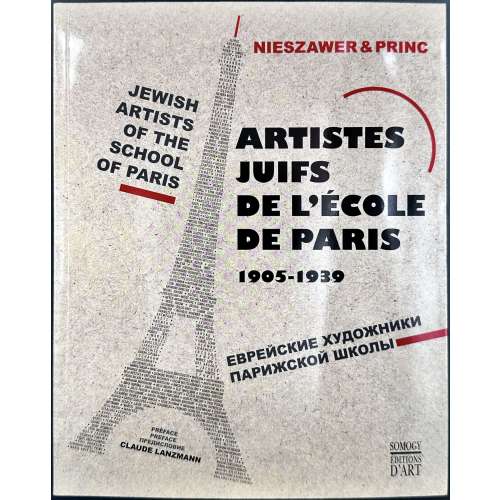 NEWSoftcover volume 240 x 192 x 40 mm in publisher’s glossy wrappers with flaps, pp. [1-6] 7-576, profusely illustrated in b/w and colour, three language publications: French (7-393), English (395-469), Russian (470-551). 2nd edition; the 1st edition © Denoël, Paris, 2000 sous le titre « Peintres juifs à Paris, École de Paris, 1905-1939 ». ISBN 978-2-7572-0701-7. Title-page: NIESZAWER & PRINC | ARTISTES JUIFS | DE L'ÉCOLE DE PARIS | 1905-1939 | JEWISH ARTISTS | OF THE SCHOOL OF PARIS | ЕВРЕЙСКИЕ ХУДОЖНИКИ | ПАРИЖСКОЙ ШКОЛЫ | Sous la direction de | Nadine Nieszawer | Expert de l'École de Paris 1905-1939 | Deborah Princ – Arthur Princ – Boris Princ | Marie Boyé Taillan – Paul Fogel | Traduction du français vers l'anglais | Deborah Princ | Traduction du français vers le russe | Oleg Semenov | PRÉFACE | PREFACE | ПРЕДИСЛОВИЕ | Claude Lanzmann | SOMOGY | ÉDITIONS | D'ART ||
NEWSoftcover volume 240 x 192 x 40 mm in publisher’s glossy wrappers with flaps, pp. [1-6] 7-576, profusely illustrated in b/w and colour, three language publications: French (7-393), English (395-469), Russian (470-551). 2nd edition; the 1st edition © Denoël, Paris, 2000 sous le titre « Peintres juifs à Paris, École de Paris, 1905-1939 ». ISBN 978-2-7572-0701-7. Title-page: NIESZAWER & PRINC | ARTISTES JUIFS | DE L'ÉCOLE DE PARIS | 1905-1939 | JEWISH ARTISTS | OF THE SCHOOL OF PARIS | ЕВРЕЙСКИЕ ХУДОЖНИКИ | ПАРИЖСКОЙ ШКОЛЫ | Sous la direction de | Nadine Nieszawer | Expert de l'École de Paris 1905-1939 | Deborah Princ – Arthur Princ – Boris Princ | Marie Boyé Taillan – Paul Fogel | Traduction du français vers l'anglais | Deborah Princ | Traduction du français vers le russe | Oleg Semenov | PRÉFACE | PREFACE | ПРЕДИСЛОВИЕ | Claude Lanzmann | SOMOGY | ÉDITIONS | D'ART || -
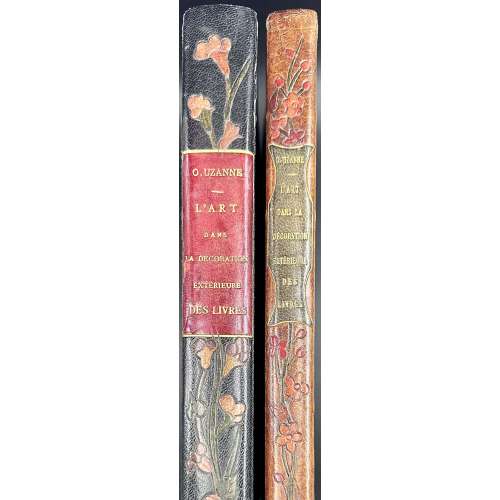 NEWTwo hardcover volumes 280 x 210 mm each, collated in-4to, with continuous pagination, total number of pages 431, uniformly bound by Pierre Ouvrard in ¾ morocco over marbled boards, spines are decorated with floral designs and gilt-lettered labels; floral diaper endpapers, top margin gilt; profusely illustrated in b/w and dual-tone. Limited edition of 1060 numbered copies with №№ 1-60 printed on wove paper (papeir Japon) and №№ 61-1060 on wove paper (papier vélin), of which this is copy № 138. Vol. 1: blue binding, original pictorial wrappers (colour woodcut) bound in; collation π4 a2 1-344: [2] h.t., [2] pictorial t.p., [i-iii] iv-vi, [1] 2-268. Engraved title-page by Leon Rudnicki, in red and black, in a frame: L'ART | DANS LA DECORATION EXTERIEURE DES LIVRES | en France et à L'Étranger | Les Couvertures illustrées | les Cartonnages d'Éditeurs | la Reliure d'Art | par | OCTAVE USANNE | {vignette} | Paris | Société Française d'Éditions d'Art | L-Henry May | 9 et 11 Rue Saint-Benoit 9 et 11 | 1898 || Imprint: Exemplaire N° 138. | IL A ÉTÉ TIRÉ DE CETTE ÉDITION | Mille Exemplaires SUR PAPIER VÉLIN | NUMÉROTÉS DE 61 A 1060 | ET | Soixante Exemplaires SUR JAPON | NUMÉROTÉS DE 1 A 60. ||
NEWTwo hardcover volumes 280 x 210 mm each, collated in-4to, with continuous pagination, total number of pages 431, uniformly bound by Pierre Ouvrard in ¾ morocco over marbled boards, spines are decorated with floral designs and gilt-lettered labels; floral diaper endpapers, top margin gilt; profusely illustrated in b/w and dual-tone. Limited edition of 1060 numbered copies with №№ 1-60 printed on wove paper (papeir Japon) and №№ 61-1060 on wove paper (papier vélin), of which this is copy № 138. Vol. 1: blue binding, original pictorial wrappers (colour woodcut) bound in; collation π4 a2 1-344: [2] h.t., [2] pictorial t.p., [i-iii] iv-vi, [1] 2-268. Engraved title-page by Leon Rudnicki, in red and black, in a frame: L'ART | DANS LA DECORATION EXTERIEURE DES LIVRES | en France et à L'Étranger | Les Couvertures illustrées | les Cartonnages d'Éditeurs | la Reliure d'Art | par | OCTAVE USANNE | {vignette} | Paris | Société Française d'Éditions d'Art | L-Henry May | 9 et 11 Rue Saint-Benoit 9 et 11 | 1898 || Imprint: Exemplaire N° 138. | IL A ÉTÉ TIRÉ DE CETTE ÉDITION | Mille Exemplaires SUR PAPIER VÉLIN | NUMÉROTÉS DE 61 A 1060 | ET | Soixante Exemplaires SUR JAPON | NUMÉROTÉS DE 1 A 60. ||Frontispice, en deux tons, de RICHARD WALLACE; Tire, Ornements, Tétes de Chapitres et Culs-de-lampe de Léon RUDNICKI.
Vol. 2: brown binding; collation: one ffl, 64 leaves of plates printed on both sides, unpaginated, then [269] 270-272 [4] two ffls. Colophon: CE LIVRE | a été achevé d'imprimer | SUR LES PRESSES TYPOGRAPHIQUES | DE LA MAISON LAHURE | à Paris | {vignette} | Le vingt-cing Novembre | 1897 | PAR LES SOINS DE L'AUTEUR |POUR | LA SOCIÉTÉ FRANÇAISE D'ÉDITION D'ART | L.-H. MAY, ÉDITEUR || Contributors: Octave Uzanne (French, 1851 – 1931) – author/compiler. L.-Henry-May (French, late 19th century) – publisher. Société française d'éditions d'art (Paris) – publisher. Léon Rudnicki (French, 1831 – 1958) – engraver/artist. Louis Rhead (British-American, 1857 – 1926) Pierre Ouvrard (Canadian, 1929 – 2008) – bookbinder. -
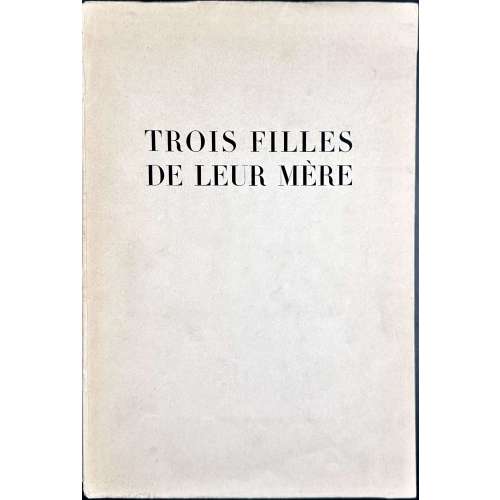 NEWA softcover volume 285 x 190 mm in cream French flapped wrapper and glassine dust cover, with lettering to front, pp.: [1-8] 9-201 [202] [4], i.e. 103 leaves, incl. frontispiece, ‘Fin’ page and leaves within the wrappers. Title-page vignette, full-page and in-text illustrations, and tailpieces after Feodor Rojankovsky by au pochoir reproductions in colour. Print run limited to 200 numbered copies, of which this is № 14. Title-page: P. L. | TROIS FILLES | DELEUR MÈRE | {vignette} | AUX DÉPENS D'UN AMATEUR | ET POUR SES AMIS || Limitation: Le présent ouvrage a été tiré à | deux cents exemplaires tous numérotés | EXEMPLAIRE 14 || Catalogue raisonné: Dutel III № 2522, p. 391; Pia II № 1341, p. 700. Contributors: Pierre Louÿs (French, 1870 – 1925) – author. Feodor Rojankovsky [Rojan; Рожанковский, Фёдор Степанович] (Russian-American, 1891 – 1970) – artist. As for the illustrations, Pascal Pia (1978) in Les Livres de l'enfer does not provide any attribution. Jean-Pierre Dutel in his Bibliographie des ouvrages érotiques publiés clandestinement en français entre 1920 et 1970 (2005) attributes the illustrations to René Ranson (René Gontran Ranson, 1891 – 1977). After that, many antiquarian dealers and bloggers (John Kruse of johnkruseblog) repeat that wrongful attribution made by Victor Arwas. Now, Mr. Dutel has instructed me to inform the audience that the attribution in Bibliographie des ouvrages érotiques was wrong and that the illustrations for this edition were produced by Feodor Rojankovsky.
NEWA softcover volume 285 x 190 mm in cream French flapped wrapper and glassine dust cover, with lettering to front, pp.: [1-8] 9-201 [202] [4], i.e. 103 leaves, incl. frontispiece, ‘Fin’ page and leaves within the wrappers. Title-page vignette, full-page and in-text illustrations, and tailpieces after Feodor Rojankovsky by au pochoir reproductions in colour. Print run limited to 200 numbered copies, of which this is № 14. Title-page: P. L. | TROIS FILLES | DELEUR MÈRE | {vignette} | AUX DÉPENS D'UN AMATEUR | ET POUR SES AMIS || Limitation: Le présent ouvrage a été tiré à | deux cents exemplaires tous numérotés | EXEMPLAIRE 14 || Catalogue raisonné: Dutel III № 2522, p. 391; Pia II № 1341, p. 700. Contributors: Pierre Louÿs (French, 1870 – 1925) – author. Feodor Rojankovsky [Rojan; Рожанковский, Фёдор Степанович] (Russian-American, 1891 – 1970) – artist. As for the illustrations, Pascal Pia (1978) in Les Livres de l'enfer does not provide any attribution. Jean-Pierre Dutel in his Bibliographie des ouvrages érotiques publiés clandestinement en français entre 1920 et 1970 (2005) attributes the illustrations to René Ranson (René Gontran Ranson, 1891 – 1977). After that, many antiquarian dealers and bloggers (John Kruse of johnkruseblog) repeat that wrongful attribution made by Victor Arwas. Now, Mr. Dutel has instructed me to inform the audience that the attribution in Bibliographie des ouvrages érotiques was wrong and that the illustrations for this edition were produced by Feodor Rojankovsky. -
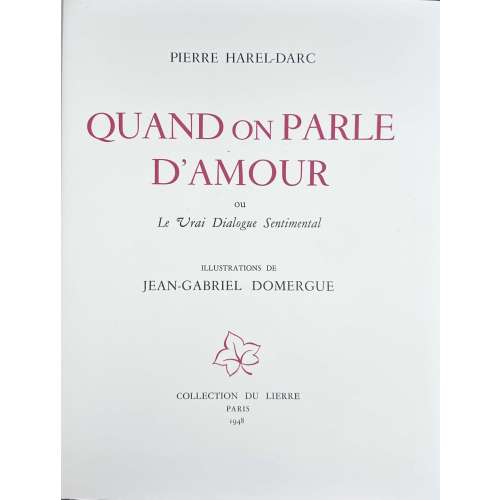 NEWSoftcover volume 330 x 255 mm, cream French flapped wrappers with crimson lettering to front in glassine dust cover housed in gilt ivy-diapered 340 x 265 mm clamshell box with full-length label to vertical side, text and 18 in-text colour lithographs printed on 18 quarto unbound gatherings of thick paper watermarked BFK Rives, plus 10 full-page colour lithographs, hand-painted with watercolours. Copy enriched with an autographed dedication to half-title and a suite of the 18 in-text b/w (uncoloured) lithographs on Pur Fil Marais paper. The print run on November 22, 1948, limited edition of 350 copies, 40 copies on vélin de Rives paper, of which this is copy № 67. Title-page (red and black): PIERRE HAREL-DARC | QUAND ON PARLE | D'AMOUR | ou | Le Vrai Dialogue Sentimental | ILLUSTRATIONS DE | JEAN-GABRIEL DOMERGUE | {fleuron} | COLLECTION DU LIERRE | PARIS | 1948 || Colophon: Ce livre composé en caractères Garamond Corps dix-huit a été achevé d'imprimer le 22 novembre 1948 par Georges Girard pour la typographie, Maurice Beaudet pour la lithographie et « le coloris» pour les aquarelles le tirage se limite à trois cent cinquante exemplaires se décomposant comme suit : Dix exemplaires sur vélin de Rives avec suites en couleurs et une aquarelle numérotés de 1 a 10 ; Vingt exemplaires sur vélin de Rives avec suites en couleurs et un dessin, numérotes de 11 a 30 ; Quarante exemplaires sur vélin de Rives avec une suite en noir, numérotes de 31 a 70 ; Deux cent quatre-vingts exemplaires sur vélin Pur Fil du Marais, numérotés de 71 a 350 ; quelques exemplaires hors commerce ont été réservés a l'auteur, a l'illustrateur, a l'éditeur et a ses amis. Exemplaire 67. Contributors: Pierre Maurice Harel [Harel-Darc] (French, 1890 – 1965) – author Jean-Gabriel Domergue (French, 1889 – 1962) Georges Girard (French, 20th century) – printer/text Maurice Beaudet (French, 20th century) – printer/lithography
NEWSoftcover volume 330 x 255 mm, cream French flapped wrappers with crimson lettering to front in glassine dust cover housed in gilt ivy-diapered 340 x 265 mm clamshell box with full-length label to vertical side, text and 18 in-text colour lithographs printed on 18 quarto unbound gatherings of thick paper watermarked BFK Rives, plus 10 full-page colour lithographs, hand-painted with watercolours. Copy enriched with an autographed dedication to half-title and a suite of the 18 in-text b/w (uncoloured) lithographs on Pur Fil Marais paper. The print run on November 22, 1948, limited edition of 350 copies, 40 copies on vélin de Rives paper, of which this is copy № 67. Title-page (red and black): PIERRE HAREL-DARC | QUAND ON PARLE | D'AMOUR | ou | Le Vrai Dialogue Sentimental | ILLUSTRATIONS DE | JEAN-GABRIEL DOMERGUE | {fleuron} | COLLECTION DU LIERRE | PARIS | 1948 || Colophon: Ce livre composé en caractères Garamond Corps dix-huit a été achevé d'imprimer le 22 novembre 1948 par Georges Girard pour la typographie, Maurice Beaudet pour la lithographie et « le coloris» pour les aquarelles le tirage se limite à trois cent cinquante exemplaires se décomposant comme suit : Dix exemplaires sur vélin de Rives avec suites en couleurs et une aquarelle numérotés de 1 a 10 ; Vingt exemplaires sur vélin de Rives avec suites en couleurs et un dessin, numérotes de 11 a 30 ; Quarante exemplaires sur vélin de Rives avec une suite en noir, numérotes de 31 a 70 ; Deux cent quatre-vingts exemplaires sur vélin Pur Fil du Marais, numérotés de 71 a 350 ; quelques exemplaires hors commerce ont été réservés a l'auteur, a l'illustrateur, a l'éditeur et a ses amis. Exemplaire 67. Contributors: Pierre Maurice Harel [Harel-Darc] (French, 1890 – 1965) – author Jean-Gabriel Domergue (French, 1889 – 1962) Georges Girard (French, 20th century) – printer/text Maurice Beaudet (French, 20th century) – printer/lithography -
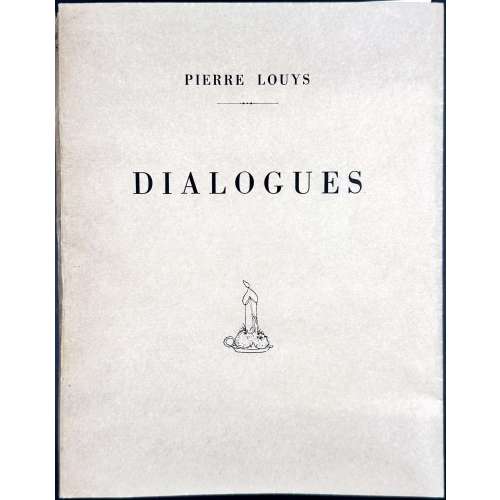 NEWSoftcover volume 245 x 192 mm in a slipcase 153 x 192 mm, cream parchment flapped wrappers with lettering to front and spine, unbound, margins untrimmed, printed on wove paper, collated in 16 unbound gatherings, unsigned, text in pink arabesque frame with a round vignette in the bottom; the contents is similar to previously published Douze douzains de dialogues ou petites scènes amoureuses by Pierre Louÿs (see LIB-3144.2023 and LIB-2819.2021 in this collection. Pagination: [1-8] 9-124 [125 colophon] [3 blanks], .i.e. 64 leaves plus 12 lithographic plates, extraneous to collation. Plates are attributed to Jean Berque. Print run of 153 copies, of which this is copy № 45. A typical case of a clandestine reproduction of erotic text with quickly made salacious illustrations during the occupation of France by the Nazis. Title-page: Pierre Louys | — | DIALOGUES | ou | Petites Scènes Amoureuses | 1943 | LES ÉDITIONS SOUS LE MANTEAU | LORIENT || Colophon: CET OUVRAGE, NON DESTINÉ A ÊTRE MIS DANS LE | COMMERCE, A ÉTÉ TIRÉ A CENT-CINQUANTE-TROIS | EXEMPLAIRES, SAVOIR : 3 EXEMPLAIRES SUR ARCHES A LA FORME, Nos 1 A 3. | 150 EXEMPLAIRES SUR RIVES PUR FIL, Nos 4 A 153. | Exemplaire N 00,045 || Catalogue raisonné: Dutel III № 1397, p. 130. Contributors: Pierre Louÿs (French, 1870 – 1925) – author. Jean Berque (French, 1896 – 1954) – atrist.
NEWSoftcover volume 245 x 192 mm in a slipcase 153 x 192 mm, cream parchment flapped wrappers with lettering to front and spine, unbound, margins untrimmed, printed on wove paper, collated in 16 unbound gatherings, unsigned, text in pink arabesque frame with a round vignette in the bottom; the contents is similar to previously published Douze douzains de dialogues ou petites scènes amoureuses by Pierre Louÿs (see LIB-3144.2023 and LIB-2819.2021 in this collection. Pagination: [1-8] 9-124 [125 colophon] [3 blanks], .i.e. 64 leaves plus 12 lithographic plates, extraneous to collation. Plates are attributed to Jean Berque. Print run of 153 copies, of which this is copy № 45. A typical case of a clandestine reproduction of erotic text with quickly made salacious illustrations during the occupation of France by the Nazis. Title-page: Pierre Louys | — | DIALOGUES | ou | Petites Scènes Amoureuses | 1943 | LES ÉDITIONS SOUS LE MANTEAU | LORIENT || Colophon: CET OUVRAGE, NON DESTINÉ A ÊTRE MIS DANS LE | COMMERCE, A ÉTÉ TIRÉ A CENT-CINQUANTE-TROIS | EXEMPLAIRES, SAVOIR : 3 EXEMPLAIRES SUR ARCHES A LA FORME, Nos 1 A 3. | 150 EXEMPLAIRES SUR RIVES PUR FIL, Nos 4 A 153. | Exemplaire N 00,045 || Catalogue raisonné: Dutel III № 1397, p. 130. Contributors: Pierre Louÿs (French, 1870 – 1925) – author. Jean Berque (French, 1896 – 1954) – atrist. -
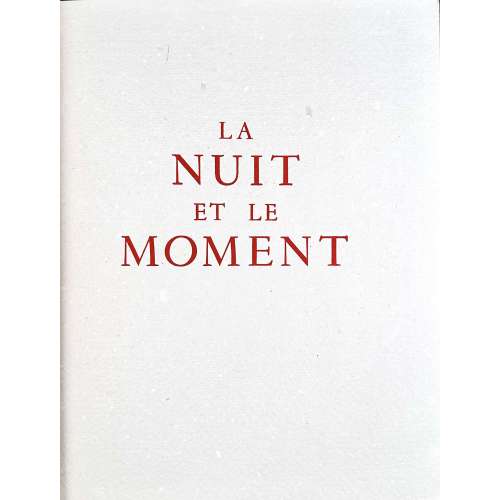 NEWHardcover volume 287 x 237 mm, bound by San Remo (signed) in red full straight-grained morocco, boards decorated with a frame of gilt and blind-stamped fillets with fleurons in the corners, spine with faux raised bands, gilt in compartments snd gilt lettering, top edge gilt, other untrimmed; pastedown with grey percaline in a red morocco frame with gilt fillet, grey percaline free endpaper; publisher’s original wrappers preserved and bound in, printed on wove paper with “Johannot” watermark. Collation: 4 fly leaves, 1st with the previous owner’s ‘EXLIBRIS JEAN PERISSE’ imprint, front wrapper, blank, h.t., t.p., pp. 1-161 [162], blank, plus 17 full-page and 2 in-text hand-coloured etchings, incl. frontispiece, A propos / Louis Icart fac-simile to verso, 6 leaves of cancelled plates, colophon, blank, rear wrapper, spine, 3 fly leaves. Title-page (red and black): PROSPER JOLYOT DE CRÉBILLON | LA | NUIT | ET LE | MOMENT | imagé de vingt-cinq eaux-fortes originales, en couleurs, | par | LOUIS ICART | {fleuron} | GEORGES GUILLOT, ÉDITEUR | 7, RUE PERRONET | PARIS || Colophon: La nuit et le moment de Prosper de Crébillon, réalisé par les éditions d'art Georges Guillot, est image de vingt-cinq eaux-fortes originales en couleurs, dont cinq en suite libre, gravées par Louis Icart. — Son tirage a été limité a 525 exemplaires, a savoir : un exemplaire unique sur Japon Super Nacré portant le n° 1, comprenant trois dessins originaux, une suite sur chine avec trois états des eaux-fortes, les gravures dans leur état définitif et un cuivre encré. — Quinze exemplaires sur Japon Impérial numérotés de 2 a 16, et neuf sur Japon Ivoire numérotés de 17 a 25, comprenant un dessin original, deux états des eaux-fortes, les gravures dans leur état définitif et un cuivre encré. — cent exemplaires sur Rives a la Forme numérotés de 26 a 125, comprenant un dessin original, une suite sanguine et les gravures dans leur état définitif. — Cent-cinquante exemplaires sur Arches a la Forme numérotés de 126 a 275, comprenant les eaux-fortes dans leur état définitif en couleurs. — Deux-cents cinquante exemplaires sur Johannot a la Forme numérotés de 276 a 525, comprenant les eaux-fortes dans leur état définitif en couleurs. — Quinze exemplaires sur différents papiers, comprenant les eaux-fortes dans leur état définitif en couleurs, réservés a l'artiste et a l'éditeur, dénommés exemplaires d'artiste et numérotés de I a XV. — Cette édition a été achevé d'imprimer a paris. Pour la typographie, sur les presses de Pierre Gaudin ; et pour les eaux-fortes, dans les ateliers en taille-douce de Manuel Robbe, le 30 avril 1946. Limitation: Print-run on April 30, 1946, limited to 525 copies plus 15 copies reserved for artist and publisher (I-XV); copies №№ 276-525 on Johannot paper, of which this is copy № 367. Catalogue raisonné: honesterotica.com; William R. Holland pp. 133-147. Contributors: Claude-Prosper Jolyot de Crébillon [Crébillon fils] (French, 1707 – 1777) – author. Louis Icart (French, 1888 – 1950) – artist. Georges Guillot (French) – publisher. Pierre Gaudin – printer/text. Ateliers en taille-douce de Manuel Robbe (French, 1872 – 1936) – printer/plates. Jean Périssé (French, b. 1947) – provenance.
NEWHardcover volume 287 x 237 mm, bound by San Remo (signed) in red full straight-grained morocco, boards decorated with a frame of gilt and blind-stamped fillets with fleurons in the corners, spine with faux raised bands, gilt in compartments snd gilt lettering, top edge gilt, other untrimmed; pastedown with grey percaline in a red morocco frame with gilt fillet, grey percaline free endpaper; publisher’s original wrappers preserved and bound in, printed on wove paper with “Johannot” watermark. Collation: 4 fly leaves, 1st with the previous owner’s ‘EXLIBRIS JEAN PERISSE’ imprint, front wrapper, blank, h.t., t.p., pp. 1-161 [162], blank, plus 17 full-page and 2 in-text hand-coloured etchings, incl. frontispiece, A propos / Louis Icart fac-simile to verso, 6 leaves of cancelled plates, colophon, blank, rear wrapper, spine, 3 fly leaves. Title-page (red and black): PROSPER JOLYOT DE CRÉBILLON | LA | NUIT | ET LE | MOMENT | imagé de vingt-cinq eaux-fortes originales, en couleurs, | par | LOUIS ICART | {fleuron} | GEORGES GUILLOT, ÉDITEUR | 7, RUE PERRONET | PARIS || Colophon: La nuit et le moment de Prosper de Crébillon, réalisé par les éditions d'art Georges Guillot, est image de vingt-cinq eaux-fortes originales en couleurs, dont cinq en suite libre, gravées par Louis Icart. — Son tirage a été limité a 525 exemplaires, a savoir : un exemplaire unique sur Japon Super Nacré portant le n° 1, comprenant trois dessins originaux, une suite sur chine avec trois états des eaux-fortes, les gravures dans leur état définitif et un cuivre encré. — Quinze exemplaires sur Japon Impérial numérotés de 2 a 16, et neuf sur Japon Ivoire numérotés de 17 a 25, comprenant un dessin original, deux états des eaux-fortes, les gravures dans leur état définitif et un cuivre encré. — cent exemplaires sur Rives a la Forme numérotés de 26 a 125, comprenant un dessin original, une suite sanguine et les gravures dans leur état définitif. — Cent-cinquante exemplaires sur Arches a la Forme numérotés de 126 a 275, comprenant les eaux-fortes dans leur état définitif en couleurs. — Deux-cents cinquante exemplaires sur Johannot a la Forme numérotés de 276 a 525, comprenant les eaux-fortes dans leur état définitif en couleurs. — Quinze exemplaires sur différents papiers, comprenant les eaux-fortes dans leur état définitif en couleurs, réservés a l'artiste et a l'éditeur, dénommés exemplaires d'artiste et numérotés de I a XV. — Cette édition a été achevé d'imprimer a paris. Pour la typographie, sur les presses de Pierre Gaudin ; et pour les eaux-fortes, dans les ateliers en taille-douce de Manuel Robbe, le 30 avril 1946. Limitation: Print-run on April 30, 1946, limited to 525 copies plus 15 copies reserved for artist and publisher (I-XV); copies №№ 276-525 on Johannot paper, of which this is copy № 367. Catalogue raisonné: honesterotica.com; William R. Holland pp. 133-147. Contributors: Claude-Prosper Jolyot de Crébillon [Crébillon fils] (French, 1707 – 1777) – author. Louis Icart (French, 1888 – 1950) – artist. Georges Guillot (French) – publisher. Pierre Gaudin – printer/text. Ateliers en taille-douce de Manuel Robbe (French, 1872 – 1936) – printer/plates. Jean Périssé (French, b. 1947) – provenance. -
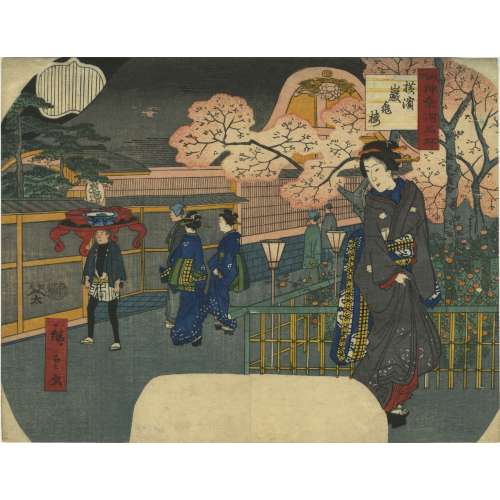 NEWIn red cartouche: Famous places in Bushū and Kanagawa (Bushū Kanagawa meisho) [武州神奈河名昕] In yellow striped square: Gankirō in Yokohama (Yokohama Gankirō) [横濱巌亀楼] / new spelling 横浜岩亀楼. The three kanji [岩亀楼] (Gankirō) are also visible on the sign or lantern above the food tray, carried on the head by a man on the left. Gankirō – the largest 'tea house' (brothel) for foreigners in the Miyozaki pleasure quarters, similar to those in Yoshiwara, in Edo. Artist: Utagawa Hiroshige II [二代目 歌川広重] (Japanese, 1826 – 1869) – a son-in-law of Andō Hiroshige. Signature: Hiroshige ga [廣重画] Dimensions: Aiban yoko-e uchiwa-e, 223 x 289 mm. Combined date/censor seal: monkey (saru - 申) and kiwame (極), 1860. Publisher: Yama-Ta; seal: [板元, 太] – Hanmoto, Ta; Marks 19-044 | U421b: An unknown publisher in Edo, fl. c. 1815-61. Another Hiroshige II's print with the same subject and even the same characters, but in 3rd month, 1859: Entrance to the Gankirō Tea House in the Miyozaki District, Yokohama, Bushu (Bushu Yokohama Gankirō) [諸国名所百景 武州横浜岩亀楼]. Utagawa Yoshikazu's [歌川芳員] depiction of the place in c. 1861 from the inside:[Thanks to Horst Graebner].
NEWIn red cartouche: Famous places in Bushū and Kanagawa (Bushū Kanagawa meisho) [武州神奈河名昕] In yellow striped square: Gankirō in Yokohama (Yokohama Gankirō) [横濱巌亀楼] / new spelling 横浜岩亀楼. The three kanji [岩亀楼] (Gankirō) are also visible on the sign or lantern above the food tray, carried on the head by a man on the left. Gankirō – the largest 'tea house' (brothel) for foreigners in the Miyozaki pleasure quarters, similar to those in Yoshiwara, in Edo. Artist: Utagawa Hiroshige II [二代目 歌川広重] (Japanese, 1826 – 1869) – a son-in-law of Andō Hiroshige. Signature: Hiroshige ga [廣重画] Dimensions: Aiban yoko-e uchiwa-e, 223 x 289 mm. Combined date/censor seal: monkey (saru - 申) and kiwame (極), 1860. Publisher: Yama-Ta; seal: [板元, 太] – Hanmoto, Ta; Marks 19-044 | U421b: An unknown publisher in Edo, fl. c. 1815-61. Another Hiroshige II's print with the same subject and even the same characters, but in 3rd month, 1859: Entrance to the Gankirō Tea House in the Miyozaki District, Yokohama, Bushu (Bushu Yokohama Gankirō) [諸国名所百景 武州横浜岩亀楼]. Utagawa Yoshikazu's [歌川芳員] depiction of the place in c. 1861 from the inside:[Thanks to Horst Graebner].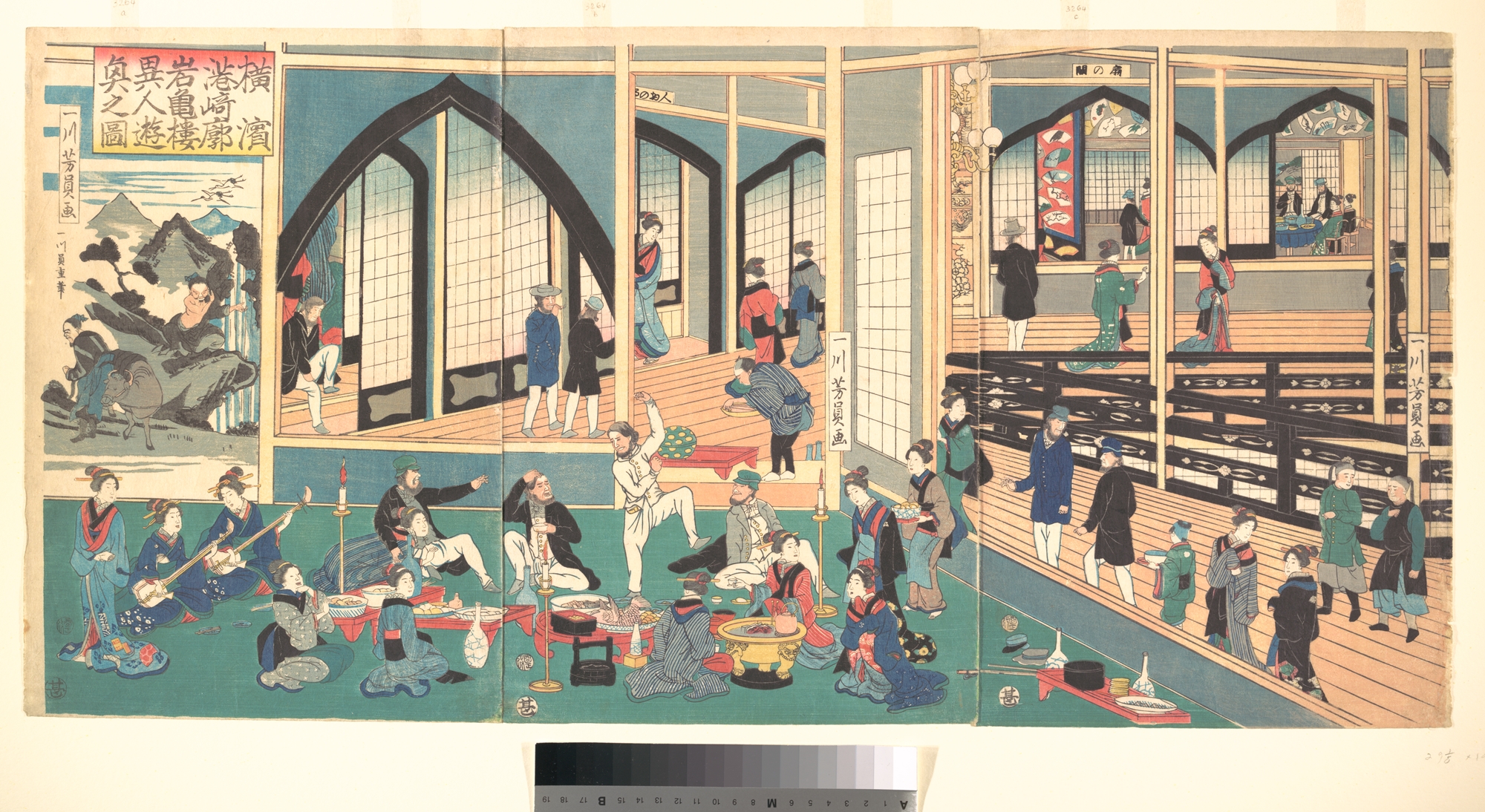
Foreigners Enjoying Themselves in the Gankirō. MET JP3264.
-
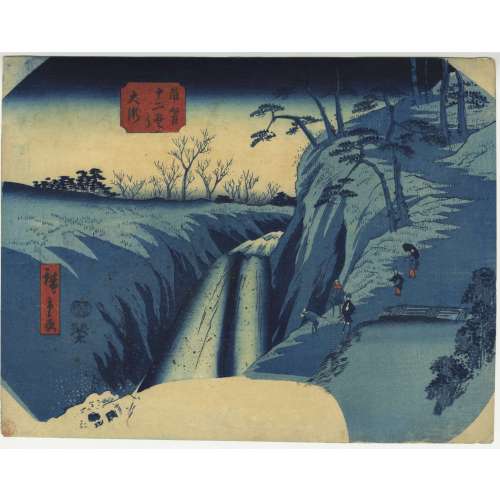 NEWTitle: The Great Waterfall at the Twelve Shrines of Tsunohazu (Tsunohazu juniso otaki) [角筈十二社大滝] from an untitled set of views of famous places in Edo. Artist: Utagawa Hiroshige II [二代目 歌川広重] (Japanese, 1826 – 1869) – a son-in-law of Andō Hiroshige. Signature: Hiroshige ga [廣重画] Dimensions: Aiban yoko-e uchiwa-e, 226 x 291 mm. Combined date/censor seal: tori, 酉 / kiwame 極 – 1861 (Man'en 2 / Bunkyū 1 from 19/II). Publisher: Yama-Ta; seal: [板元, 太] – Hanmoto, Ta; Marks 19-044 | U421b: An unknown publisher in Edo, fl. c. 1815-61. Provenance: Collection of Maroni, Albert (French, 1852 – 1923), red stamp in the bottom-left corner.
NEWTitle: The Great Waterfall at the Twelve Shrines of Tsunohazu (Tsunohazu juniso otaki) [角筈十二社大滝] from an untitled set of views of famous places in Edo. Artist: Utagawa Hiroshige II [二代目 歌川広重] (Japanese, 1826 – 1869) – a son-in-law of Andō Hiroshige. Signature: Hiroshige ga [廣重画] Dimensions: Aiban yoko-e uchiwa-e, 226 x 291 mm. Combined date/censor seal: tori, 酉 / kiwame 極 – 1861 (Man'en 2 / Bunkyū 1 from 19/II). Publisher: Yama-Ta; seal: [板元, 太] – Hanmoto, Ta; Marks 19-044 | U421b: An unknown publisher in Edo, fl. c. 1815-61. Provenance: Collection of Maroni, Albert (French, 1852 – 1923), red stamp in the bottom-left corner.An aizuri-e (blue print) on a popular topic, many times depicted by Andō Hiroshige and Hiroshige II, including the below print by the latter No. 45, the Twelve Kumano Shrines at Tsunohazu (Tsunohazu Kumano jûnisha), from the series Forty-Eight Famous Views of Edo (Edo meisho yonjûhakkei)「江戸名所四十八景 四十五 角筈熊野十二社」
-
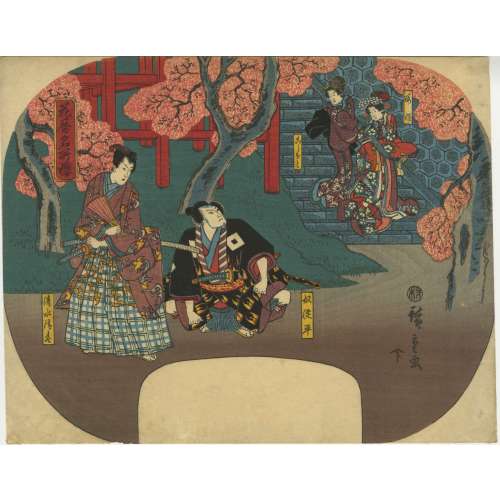 NEWTitle: Flower calendar for the famous cherry blossoms (Hana goyomi meisho sakura) [花暦名所櫻]. A scene from an imaginary (mitate) kabuki play. Names of the characters (left to right): Kiyomizu/Shimizu Seigen [清水清玄]; Yakko (footman) Yodohei [奴淀平]; koshimoto (court lady) [こしもと]; Sakura hime (princess) [桜姫]. The same characters appear in a few real kabuki plays. Artist: Utagawa Hiroshige [歌川 広重] a.k.a. Andō Hiroshige [安藤 広重] (Japanese, 1797 – 1858) Signature: Hiroshige ga [廣重画] Dimensions: Aiban yoko-e uchiwa-e, 232 x 295 mm. Censor seal: "Mura" [村] for Murata Sahei [村田佐兵衛], used from VI/1842 to V/1846 (Tenpō 13 – Kōka 3). Publisher: Enshūya Matabei [遠州屋又兵衛] (Enterprise, active c. 1768 – 1881); seal: "To" (ト) (Marks 01-031 | 057a). [Thanks to Horst Graebner].
NEWTitle: Flower calendar for the famous cherry blossoms (Hana goyomi meisho sakura) [花暦名所櫻]. A scene from an imaginary (mitate) kabuki play. Names of the characters (left to right): Kiyomizu/Shimizu Seigen [清水清玄]; Yakko (footman) Yodohei [奴淀平]; koshimoto (court lady) [こしもと]; Sakura hime (princess) [桜姫]. The same characters appear in a few real kabuki plays. Artist: Utagawa Hiroshige [歌川 広重] a.k.a. Andō Hiroshige [安藤 広重] (Japanese, 1797 – 1858) Signature: Hiroshige ga [廣重画] Dimensions: Aiban yoko-e uchiwa-e, 232 x 295 mm. Censor seal: "Mura" [村] for Murata Sahei [村田佐兵衛], used from VI/1842 to V/1846 (Tenpō 13 – Kōka 3). Publisher: Enshūya Matabei [遠州屋又兵衛] (Enterprise, active c. 1768 – 1881); seal: "To" (ト) (Marks 01-031 | 057a). [Thanks to Horst Graebner]. -
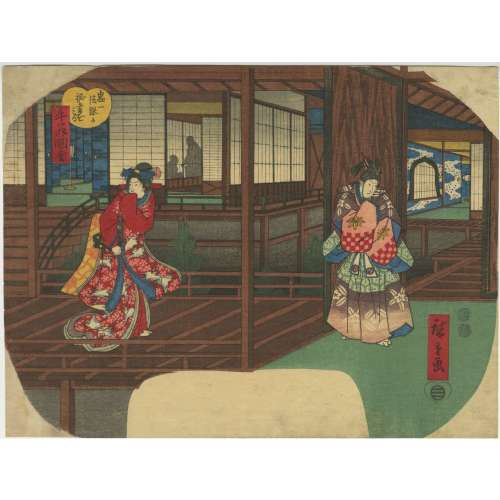 NEWTitle: The Secret Meeting between Ushiwakamaru and the Daughter of Kiichi Hōgen (Kiichi Hōgen ga hisho o miro) [鬼一法眼が秘書をみる] Series: Scenes from the life of Ushiwaka (Ushiwaka zue) [牛若図会] Artist: Utagawa Hiroshige [歌川 広重] a.k.a. Andō Hiroshige [安藤 広重] (Japanese, 1797 – 1858) Signature: Hiroshige ga [廣重画] Dimensions: Aiban yoko-e uchiwa-e, 226 x 303 mm. Censor seal: Hama & Magome [濱 / 馬込]: 1/1849 – 2/1852 (Kaei 2-5) Publisher: Ibaya Senzaburō [伊場屋仙三郎] (Japanese, fl. C. 1845 – 1847), seal: San [三] (Marks 11-001 | 127c). According to Rupert Faulkner (2001), another copy of this fan print is housed at Ōta Memorial Museum (ŌMM 1998, № 258). There are four other known prints from this series: (1) The Meeting at Yahagi: The Beginnings of the Jorurijunidan Story (Yahagi no Shuku Jorurijunidan no Hajime); (2) Ushiwakamaru practising swordsmanship at Sojogatani (ŌMM 1998, no.256); (3) Ushiwakamaru's encounter with Benkei on Gojo Bridge (Matsuki 1924, no.93); and (4) Ise no Saburo swearing an oath of loyalty to Ushiwakamaru (Kanagawa Prefectural Museum of Cultural History). Kiichi Hōgen [鬼一法眼] is a legendary monk and warrior who trained Ushiwakamaru (young Minamoto no Yoshitsune) in swordsmanship, tactics, and magic.Another print (Ushiwakamaru's encounter with Benkei on Gojo Bridge) from this series is in the collection of the Art Institute of Chicago under the title Killing One Thousand People at Gojo Bridge (Gojo no hashi sennin kiri).
NEWTitle: The Secret Meeting between Ushiwakamaru and the Daughter of Kiichi Hōgen (Kiichi Hōgen ga hisho o miro) [鬼一法眼が秘書をみる] Series: Scenes from the life of Ushiwaka (Ushiwaka zue) [牛若図会] Artist: Utagawa Hiroshige [歌川 広重] a.k.a. Andō Hiroshige [安藤 広重] (Japanese, 1797 – 1858) Signature: Hiroshige ga [廣重画] Dimensions: Aiban yoko-e uchiwa-e, 226 x 303 mm. Censor seal: Hama & Magome [濱 / 馬込]: 1/1849 – 2/1852 (Kaei 2-5) Publisher: Ibaya Senzaburō [伊場屋仙三郎] (Japanese, fl. C. 1845 – 1847), seal: San [三] (Marks 11-001 | 127c). According to Rupert Faulkner (2001), another copy of this fan print is housed at Ōta Memorial Museum (ŌMM 1998, № 258). There are four other known prints from this series: (1) The Meeting at Yahagi: The Beginnings of the Jorurijunidan Story (Yahagi no Shuku Jorurijunidan no Hajime); (2) Ushiwakamaru practising swordsmanship at Sojogatani (ŌMM 1998, no.256); (3) Ushiwakamaru's encounter with Benkei on Gojo Bridge (Matsuki 1924, no.93); and (4) Ise no Saburo swearing an oath of loyalty to Ushiwakamaru (Kanagawa Prefectural Museum of Cultural History). Kiichi Hōgen [鬼一法眼] is a legendary monk and warrior who trained Ushiwakamaru (young Minamoto no Yoshitsune) in swordsmanship, tactics, and magic.Another print (Ushiwakamaru's encounter with Benkei on Gojo Bridge) from this series is in the collection of the Art Institute of Chicago under the title Killing One Thousand People at Gojo Bridge (Gojo no hashi sennin kiri).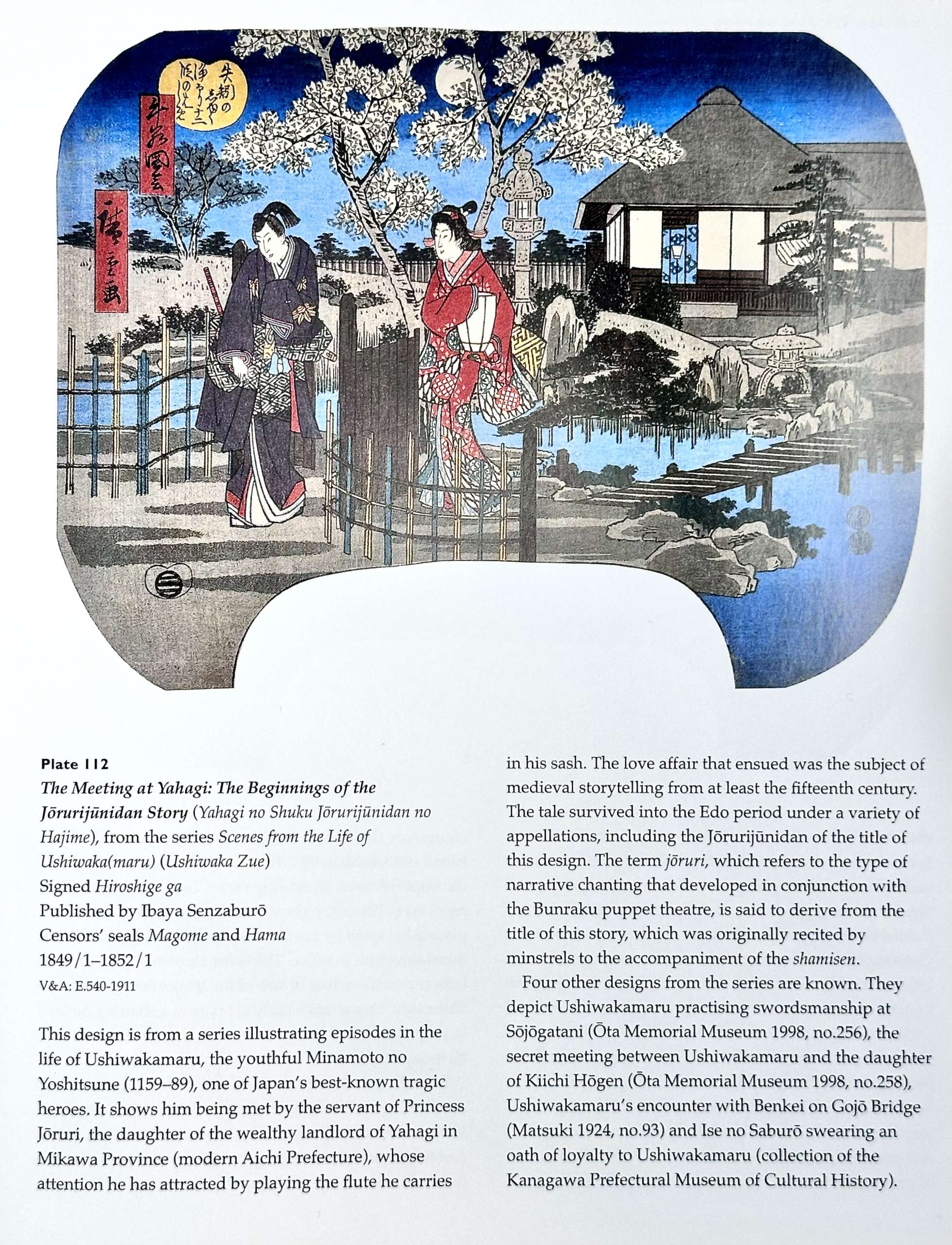
Rupert Faulkner (2001)
Reference: (1) Rupert Faulkner. Hiroshige Fan Prints / Victoria and Albert Museum, Far Eastern Series. — London: V&A Publications; NY: Harry N. Abrams, Inc., 2001. (2) Christophe Marquet. Hiroshige: Les éventails d'Edo / Estampes de la collection Georges Leskowicz. — Paris: In fine, 2022. [Thanks to Horst Graebner].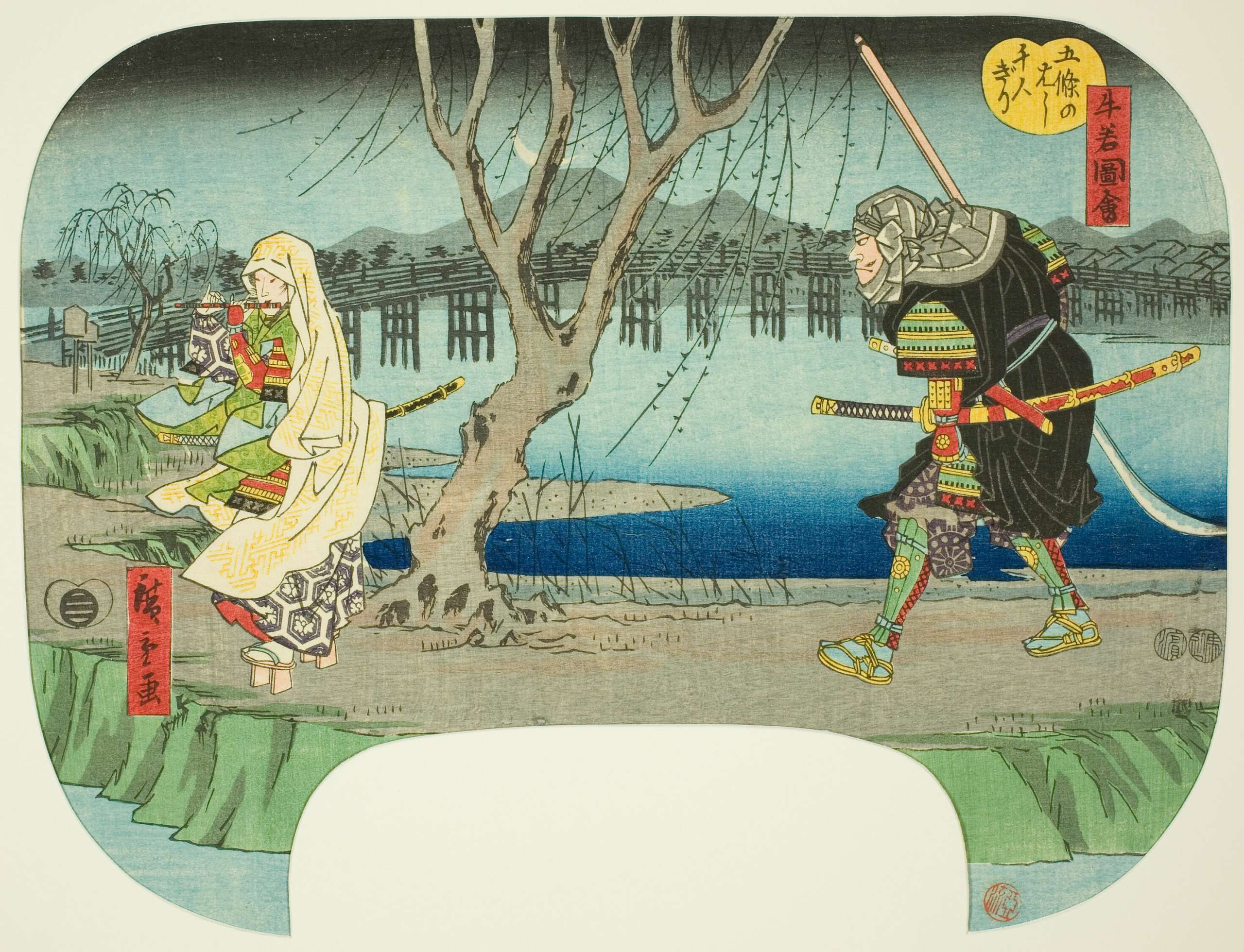
AIC Reference Number 1925.3802
-
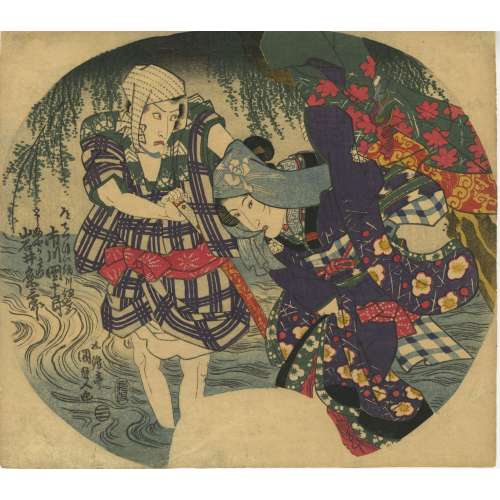 NEWIchikawa Danjūrō VII [市川団十郎] and Iwai Kumesaburō II [岩井粂三郎] as Kinugawa Iemon [絹川伊右衛門] and Tōfuya Kasane [とうふやヶさね], resp., in kabuki play Banzei okuni kabuki [万歳阿国歌舞妓], performed at Ichimura Theatre [市村座] on March, 21, 1827. References: Kunisada Project; Waseda University. Ichikawa Danjūrō VII [市川団十郎] (Japanese, 1791 – 1859); other names: Ichikawa Ebizō V, Ichikawa Hakuen II, Ichikawa Shinnosuke I. Iwai Hanshirō VI [[岩井半四郎] (Japanese, 1799 – 1836); other names: Iwai Hanshirō VI, Iwai Kumesaburō II, Iwai Hisajirō I, Baiga (poetry name), Shūka (poetry name). Artist: Utagawa Kunisada [歌川 国貞], a.k.a. Utagawa Toyokuni III [三代 歌川 豊国] (Japanese, 1786 – 1865). Signed: Gototei Kunisada ga [五渡亭國貞画]. Publisher: Ibaya Senzaburō [伊場屋仙三郎] (Japanese, fl. 1790s-1860s). Date seal and aratame seal: boar (亥), Bunsei 10 – 1827. Untrimmed fan print (aiban yoko-e uchiwa-e), 235 x 270 mm. Ichimura-za Kabuki Playbill (Tsuji banzuke):
NEWIchikawa Danjūrō VII [市川団十郎] and Iwai Kumesaburō II [岩井粂三郎] as Kinugawa Iemon [絹川伊右衛門] and Tōfuya Kasane [とうふやヶさね], resp., in kabuki play Banzei okuni kabuki [万歳阿国歌舞妓], performed at Ichimura Theatre [市村座] on March, 21, 1827. References: Kunisada Project; Waseda University. Ichikawa Danjūrō VII [市川団十郎] (Japanese, 1791 – 1859); other names: Ichikawa Ebizō V, Ichikawa Hakuen II, Ichikawa Shinnosuke I. Iwai Hanshirō VI [[岩井半四郎] (Japanese, 1799 – 1836); other names: Iwai Hanshirō VI, Iwai Kumesaburō II, Iwai Hisajirō I, Baiga (poetry name), Shūka (poetry name). Artist: Utagawa Kunisada [歌川 国貞], a.k.a. Utagawa Toyokuni III [三代 歌川 豊国] (Japanese, 1786 – 1865). Signed: Gototei Kunisada ga [五渡亭國貞画]. Publisher: Ibaya Senzaburō [伊場屋仙三郎] (Japanese, fl. 1790s-1860s). Date seal and aratame seal: boar (亥), Bunsei 10 – 1827. Untrimmed fan print (aiban yoko-e uchiwa-e), 235 x 270 mm. Ichimura-za Kabuki Playbill (Tsuji banzuke): -
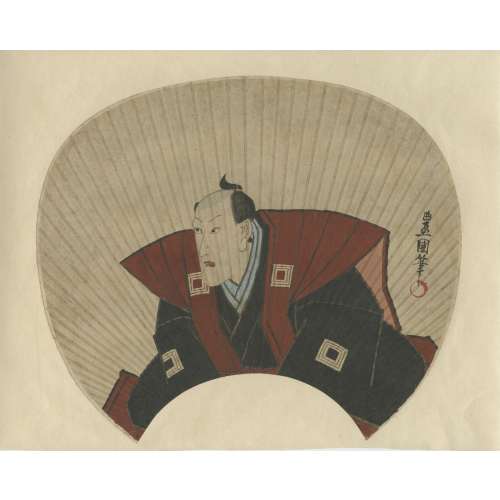 NEWRigid uchiwa fan, ink and colour on paper. Kabuki actor Ichikawa Danjūrō VIII in a crimson red robe, on his knees in a ceremonial bowing position to the audience during a formal stage announcement before the performance (Kojo, 口上). The fan has been used, dismounted from the frame, and laid onto Japanese paper, hence the rib marks. Painted c. 1850. Ichikawa Danjūrō VIII [市川団十郎] (Japanese, 1823 – 1854); other names: Ichikawa Ebizō VI, Ichikawa Shinnosuke II. Artist: Utagawa Kunisada [歌川 国貞], a.k.a. Utagawa Toyokuni III [三代 歌川 豊国] (Japanese, 1786 – 1865). Signed: Toyokuni hitsu [豊国筆] with red toshidama seal. Dimensions: 280 x 325 mm Reference: Ichikawa Danjūrō VIII by Utagawa Kuniyoshi 歌川国芳, 1855.
NEWRigid uchiwa fan, ink and colour on paper. Kabuki actor Ichikawa Danjūrō VIII in a crimson red robe, on his knees in a ceremonial bowing position to the audience during a formal stage announcement before the performance (Kojo, 口上). The fan has been used, dismounted from the frame, and laid onto Japanese paper, hence the rib marks. Painted c. 1850. Ichikawa Danjūrō VIII [市川団十郎] (Japanese, 1823 – 1854); other names: Ichikawa Ebizō VI, Ichikawa Shinnosuke II. Artist: Utagawa Kunisada [歌川 国貞], a.k.a. Utagawa Toyokuni III [三代 歌川 豊国] (Japanese, 1786 – 1865). Signed: Toyokuni hitsu [豊国筆] with red toshidama seal. Dimensions: 280 x 325 mm Reference: Ichikawa Danjūrō VIII by Utagawa Kuniyoshi 歌川国芳, 1855. -
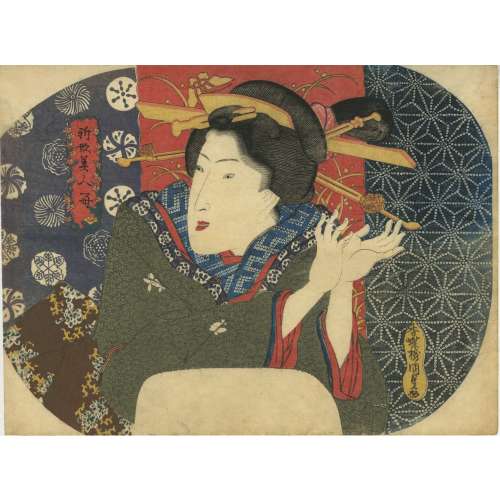 NEWHalf-length portrait of a beautiful young woman wearing a chrysanthemum-patterned green kimono, face directed 3/4 to the right, holding her hands together and fingers spread, arranging the hairpins in her elaborate hairdo; garments of different colours and pattern designs on the background. Series: The taste of the new type of woman (Shingata bijin konomi) [新形美人好]. Artist: Utagawa Kunisada [歌川 国貞], a.k.a. Utagawa Toyokuni III [三代 歌川 豊国] (Japanese, 1786 – 1865). Signed: Kōchōrō Kunisada ga [香朝楼國貞画] in a yellow double-gourd cartouche. No publisher seal. No censor/date seal. Media: Untrimmed fan print (Aiban yoko-e uchiwa-e), 228 x 305 mm.
NEWHalf-length portrait of a beautiful young woman wearing a chrysanthemum-patterned green kimono, face directed 3/4 to the right, holding her hands together and fingers spread, arranging the hairpins in her elaborate hairdo; garments of different colours and pattern designs on the background. Series: The taste of the new type of woman (Shingata bijin konomi) [新形美人好]. Artist: Utagawa Kunisada [歌川 国貞], a.k.a. Utagawa Toyokuni III [三代 歌川 豊国] (Japanese, 1786 – 1865). Signed: Kōchōrō Kunisada ga [香朝楼國貞画] in a yellow double-gourd cartouche. No publisher seal. No censor/date seal. Media: Untrimmed fan print (Aiban yoko-e uchiwa-e), 228 x 305 mm. -
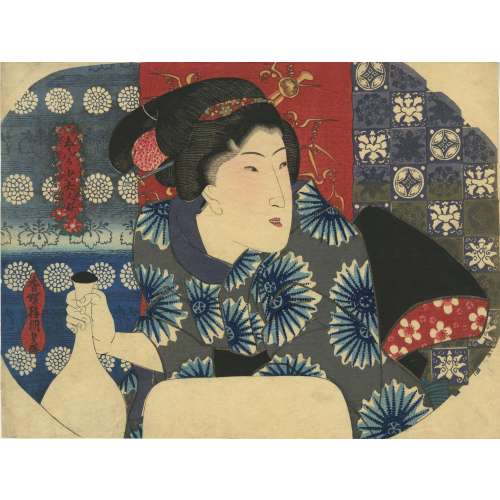 NEWSeries: The taste of the new type of woman (Shingata bijin konomi) [志んかた美人好]. Artist: Utagawa Kunisada [歌川 国貞], a.k.a. Utagawa Toyokuni III [三代 歌川 豊国] (Japanese, 1786 – 1865). Signed: Kōchōrō Kunisada ga [香朝楼國貞画] in a red double-gourd cartouche. No publisher seal. No censor/date seal. Media: Untrimmed fan print (Aiban yoko-e uchiwa-e), 228 x 302 mm.
NEWSeries: The taste of the new type of woman (Shingata bijin konomi) [志んかた美人好]. Artist: Utagawa Kunisada [歌川 国貞], a.k.a. Utagawa Toyokuni III [三代 歌川 豊国] (Japanese, 1786 – 1865). Signed: Kōchōrō Kunisada ga [香朝楼國貞画] in a red double-gourd cartouche. No publisher seal. No censor/date seal. Media: Untrimmed fan print (Aiban yoko-e uchiwa-e), 228 x 302 mm. -
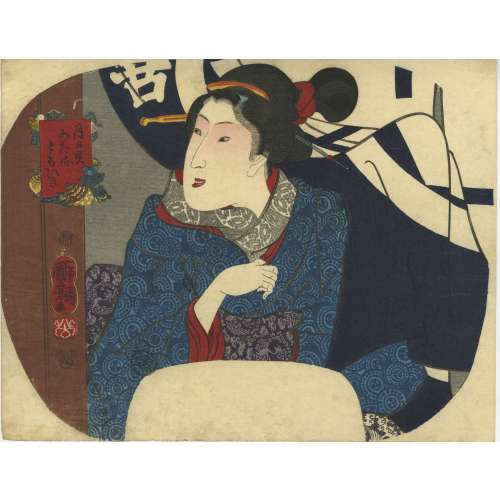 NEWSeries: Moon and sun shells for tomobiki (Tsukihigai ataru tomobiki) [月日貝あたるともびき] – hiragana inscription in the red cartouche. According to Kuniyoshi Project, Tomobiki (友引) is a fortuitous day for conducting business. There are also other meanings of the same notion of 友引. Artist: Utagawa Kuniyoshi [歌川 國芳] (1798 – 1861). Signed: Ichiyûsai Kuniyoshi ga [一勇斎 國芳戯画] (drawn by Ichiyūsai Kuniyoshi) in a red double-gourd cartouche with a kiri-mon seal beneath. Publisher: Ibaya Kyūbei [伊場屋久兵衛] (Japanese, 1804 – 1851); seal [板元,久] – Hanmoto, Kyū; Marks 19-040|126e. Single nanushi censor seal: Mura [村] = Murata Sahei [村田佐右衛] (VI/1842 – V/1846). This series has five more known prints; some have Tanaka [田中] censor seal (I/1844–II/1845). Media: Fan print (uchiwa-e, 団扇絵), 230 x 297 mm.
NEWSeries: Moon and sun shells for tomobiki (Tsukihigai ataru tomobiki) [月日貝あたるともびき] – hiragana inscription in the red cartouche. According to Kuniyoshi Project, Tomobiki (友引) is a fortuitous day for conducting business. There are also other meanings of the same notion of 友引. Artist: Utagawa Kuniyoshi [歌川 國芳] (1798 – 1861). Signed: Ichiyûsai Kuniyoshi ga [一勇斎 國芳戯画] (drawn by Ichiyūsai Kuniyoshi) in a red double-gourd cartouche with a kiri-mon seal beneath. Publisher: Ibaya Kyūbei [伊場屋久兵衛] (Japanese, 1804 – 1851); seal [板元,久] – Hanmoto, Kyū; Marks 19-040|126e. Single nanushi censor seal: Mura [村] = Murata Sahei [村田佐右衛] (VI/1842 – V/1846). This series has five more known prints; some have Tanaka [田中] censor seal (I/1844–II/1845). Media: Fan print (uchiwa-e, 団扇絵), 230 x 297 mm.



